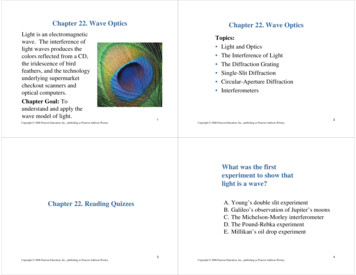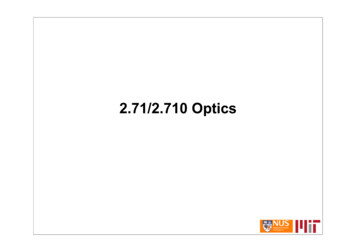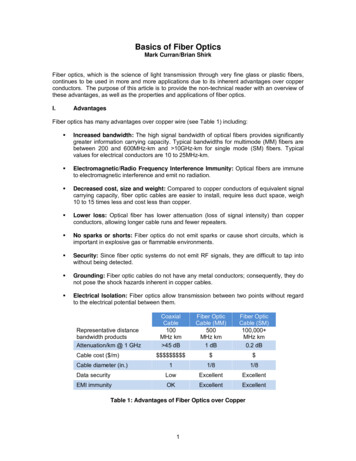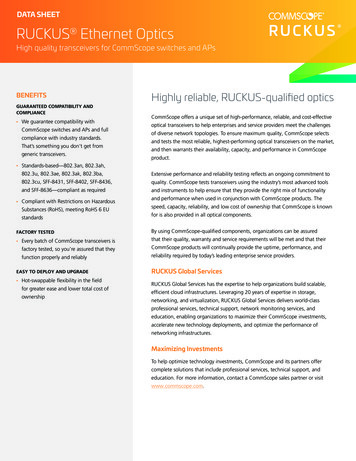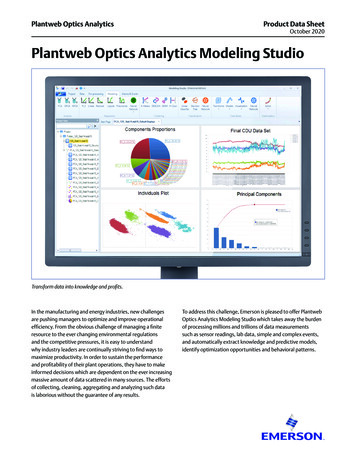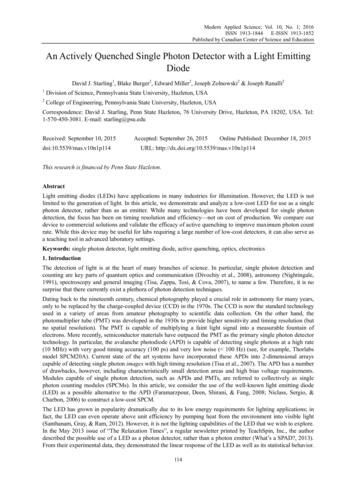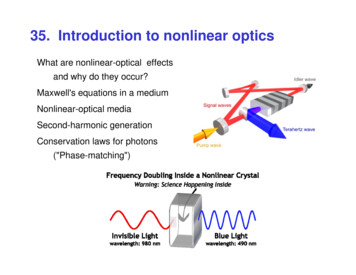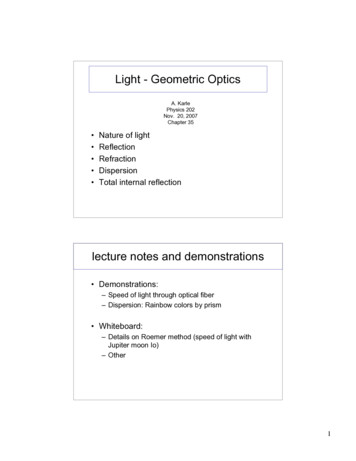
Transcription
Light - Geometric OpticsA. KarlePhysics 202Nov. 20, 2007Chapter 35 Nature of lightReflectionRefractionDispersionTotal internal reflectionlecture notes and demonstrations Demonstrations:– Speed of light through optical fiber– Dispersion: Rainbow colors by prism Whiteboard:– Details on Roemer method (speed of light withJupiter moon Io)– Other1
Nature of light: particles? Until the end of the 19th century, light wasconsidered to be a stream of particles. The particles were either emitted by the object beingviewed or emanated from the eyes of the viewer Isaac Newton (1642-1727) was the chief architect ofthe particle theory of light– He believed the particles left the object and stimulated thesense of sight upon entering the eyes– This was the view at the end of the 18th centuryNature of light: waves? Christian Huygens (1629-1695) argued that light might besome sort of a wave motion Thomas Young (1801) provided the first clear demonstrationof the wave nature of light– He showed that light rays interfere with each other– Such behavior could not be explained by particles During the nineteenth century, other developments led to thegeneral acceptance of the wave theory of light Maxwell asserted that light was a form of high-frequencyelectromagnetic wave Hertz confirmed Maxwell’s predictions– This was the view at the end of 19th century!But: new problems arose just as everything seemed fine!2
Nature of light: particle or wave?- or both? Some experiments could not be explained bythe wave nature of light The photoelectric effect was a majorphenomenon not explained by waves– When light strikes a metal surface, electrons aresometimes ejected from the surface– The kinetic energy of the ejected electron isindependent of the frequency of the lightMeasurement of the Speed of Light – Roemer’s Method Ole Roemer (1675) measuredthe periods of revolution of Io, amoon of Jupiter, as Jupiterrevolved around the sun The periods of revolution– were longer when the Earthwas receding from Jupiter– and shorter when the Earthwas approaching Using Roemer’s data,Huygens estimated the lowerlimit of the speed of light to be2.3 x 108 m/s– Finite speed!– Reasonably close!3
Measurement of the Speed of Light Demonstration: Measure time delay of an optical pulse through anoptical fiber of 30 m length. Observed delay: 100 nsec Approximately the speed of light. C 30 m / 100 nsec Ray Approximation The rays are straightlines perpendicular tothe wave frontsIf a wave meets a barrier, wewill assume that λ d– d is the diameter of theopening This approximation is good forthe study of mirrors, lenses,prisms, etc.4
Specular ReflectionLaw of ReflectionLaw of Reflectionθ1’ θ1 Specular reflection isreflection from a smoothsurfaceThe incident ray, the reflectedray and the normal are all inthe same planeLight in a Medium The light enters from the left The light may encounter anelectron The electron may absorb the light,oscillate, and reradiate the light The absorption and radiationcause the average speed of thelight moving through the materialto decrease5
The Index of Refraction The speed of light in any material is less than its speed invacuum The index of refraction, n, of a medium can be defined as For a vacuum, n 1For other media, n 1For air: n 1.00029 1Frequency Between Media As light travels from onemedium to another, itsfrequency does notchange – Both the wave speed andthe wavelength do change– The wavefronts do not pileup, nor are created ordestroyed at the boundary,so ƒ must stay the samev ƒλ on both sides6
Index of Refraction - Snell’s Law The frequency stays the same as the wave travels from one medium tothe otherv ƒλ– ƒ1 ƒ2 but v1 v2 so λ1 λ 2The ratio of the indices of refraction:λ1n1 λ2n2Snell’s law of refraction:n1 sin θ1 n2 sin θ2Huygens’s Principle Huygens assumed that light is aform of wave motion rather thana stream of particles Huygens’s Principle is ageometric construction fordetermining the position of a newwave at some point based on theknowledge of the wave front thatpreceded it7
Huygens’s Construction for a Plane WaveHuygens’s Principle and the Law ofRefraction Ray 1 strikes the surface andat a time interval t later, ray2 strikes the surfaceDuring this time interval, thewave at A sends out awavelet, centered at A,toward DBC sin θ1 v1 ΔtAD sin θ2 v2 ΔtSnell’s Law8
Variation of Index of Refraction withWavelength Dispersion The index of refraction for amaterial generally decreaseswith increasing wavelength Violet light bends more thanred light when passing into arefracting materialRefraction in a Prism Since all the colorshave different angles ofdeviation, white lightwill spread out into aspectrum– Violet deviates the most– Red deviates the least– The remaining colorsare in between9
The Rainbow At the back surface the light isreflected It is refracted again as it returnsto the front surface and movesinto the air The rays leave the drop atvarious angles– The angle between the white lightand the most intense violet ray is40 – The angle between the white lightand the most intense red ray is42 Observing the Rainbow If a raindrop high in the sky is observed, the red ray is seen A drop lower in the sky would direct violet light to the observer The other colors of the spectra lie in between the red and theviolet10
Total Internal Reflection A phenomenon called total internalreflection can occur when light is directedfrom a medium having a given index ofrefraction toward one having a lower index ofrefractionPossible Beam Directions Possible directions of thebeam are indicated by raysnumbered 1 through 5 The refracted rays are bentaway from the normalsince n1 n211
Critical Angle There is a particular angleof incidence that will resultin an angle of refraction of90 – This angle of incidence iscalled the critical angle, θCFiber Optics An application of internalreflection Plastic or glass rods are used to“pipe” light from one place toanother Applications include:– medical use of fiber opticcables for diagnosis andcorrection of medicalproblems– Telecommunications12
Construction of an Optical Fiber The transparent core issurrounded by cladding– The cladding has a lower nthan the core– This allows the light in thecore to experience totalinternal reflection The combination issurrounded by thejacketFermat’s principleThe path a beam of light takes between two points is the onewhich is traversed in the least time.ABIsotropic medium: constantvelocity.Minimum time: minimumpath length.How does the lightknow which is thefastest way?13
Example: Propagation of sound wavesin ice at the South PoleMeasurable refraction in firn:Little refraction below firn:Understand refraction in order to understandFermat’s principle Fermat’s principle offers a fascinating view. How do the photons know which is the fastestway? It reminds of other principles in Physics:– Principle of least action.14
Pool light A small underwater pool light is 1.00 mbelow the surface. The light emerging fromthe water forms a circle on the water surface.What is the diameter of this circle?15
the wave nature of light The photoelectric effect was a major phenomenon not explained by waves -When light strikes a metal surface, electrons are sometimes ejected from the surface -The kinetic energy of the ejected electron is independent of the frequency of the light Measurement of the Speed of Light - Roemer's Method
